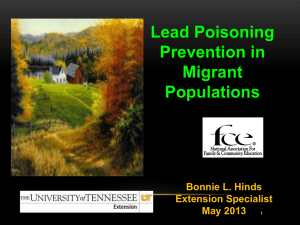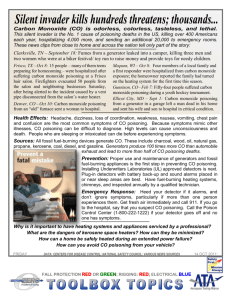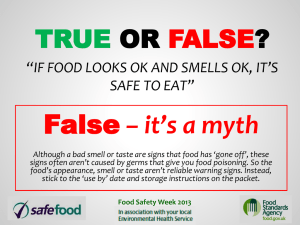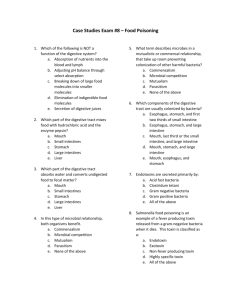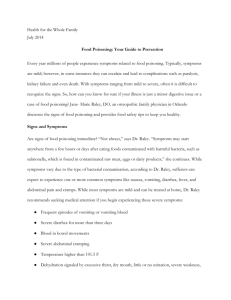profile of organophosphorus poisoning in south east rajasthan in
advertisement
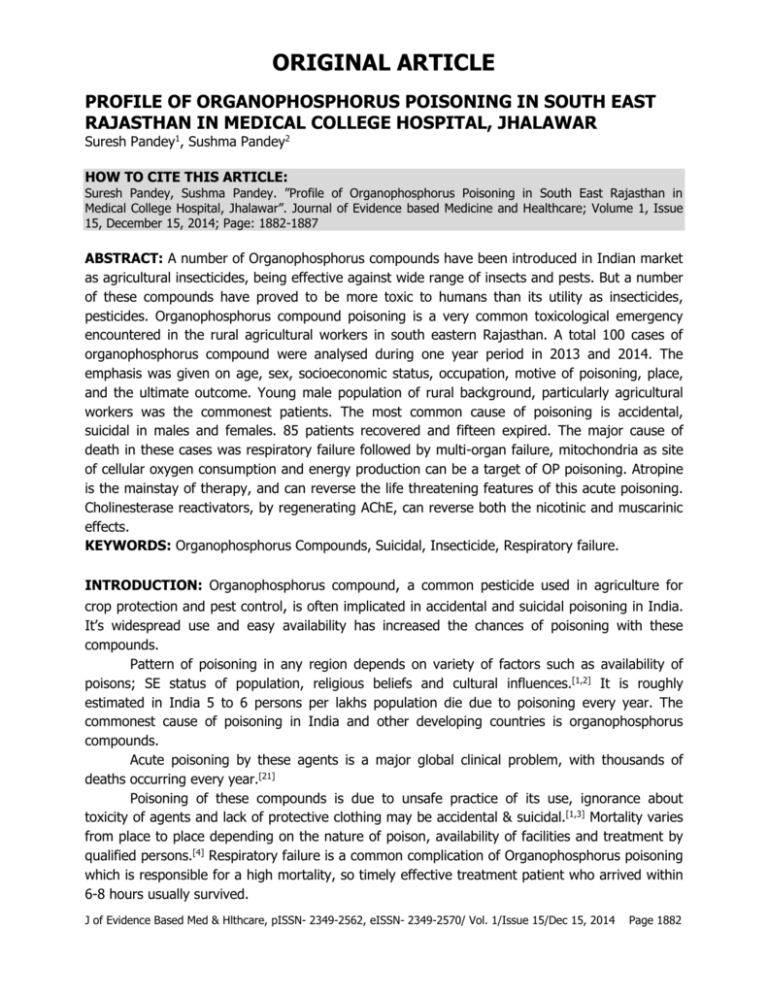
ORIGINAL ARTICLE PROFILE OF ORGANOPHOSPHORUS POISONING IN SOUTH EAST RAJASTHAN IN MEDICAL COLLEGE HOSPITAL, JHALAWAR Suresh Pandey1, Sushma Pandey2 HOW TO CITE THIS ARTICLE: Suresh Pandey, Sushma Pandey. ”Profile of Organophosphorus Poisoning in South East Rajasthan in Medical College Hospital, Jhalawar”. Journal of Evidence based Medicine and Healthcare; Volume 1, Issue 15, December 15, 2014; Page: 1882-1887 ABSTRACT: A number of Organophosphorus compounds have been introduced in Indian market as agricultural insecticides, being effective against wide range of insects and pests. But a number of these compounds have proved to be more toxic to humans than its utility as insecticides, pesticides. Organophosphorus compound poisoning is a very common toxicological emergency encountered in the rural agricultural workers in south eastern Rajasthan. A total 100 cases of organophosphorus compound were analysed during one year period in 2013 and 2014. The emphasis was given on age, sex, socioeconomic status, occupation, motive of poisoning, place, and the ultimate outcome. Young male population of rural background, particularly agricultural workers was the commonest patients. The most common cause of poisoning is accidental, suicidal in males and females. 85 patients recovered and fifteen expired. The major cause of death in these cases was respiratory failure followed by multi-organ failure, mitochondria as site of cellular oxygen consumption and energy production can be a target of OP poisoning. Atropine is the mainstay of therapy, and can reverse the life threatening features of this acute poisoning. Cholinesterase reactivators, by regenerating AChE, can reverse both the nicotinic and muscarinic effects. KEYWORDS: Organophosphorus Compounds, Suicidal, Insecticide, Respiratory failure. INTRODUCTION: Organophosphorus compound, a common pesticide used in agriculture for crop protection and pest control, is often implicated in accidental and suicidal poisoning in India. It’s widespread use and easy availability has increased the chances of poisoning with these compounds. Pattern of poisoning in any region depends on variety of factors such as availability of poisons; SE status of population, religious beliefs and cultural influences.[1,2] It is roughly estimated in India 5 to 6 persons per lakhs population die due to poisoning every year. The commonest cause of poisoning in India and other developing countries is organophosphorus compounds. Acute poisoning by these agents is a major global clinical problem, with thousands of deaths occurring every year.[21] Poisoning of these compounds is due to unsafe practice of its use, ignorance about toxicity of agents and lack of protective clothing may be accidental & suicidal.[1,3] Mortality varies from place to place depending on the nature of poison, availability of facilities and treatment by qualified persons.[4] Respiratory failure is a common complication of Organophosphorus poisoning which is responsible for a high mortality, so timely effective treatment patient who arrived within 6-8 hours usually survived. J of Evidence Based Med & Hlthcare, pISSN- 2349-2562, eISSN- 2349-2570/ Vol. 1/Issue 15/Dec 15, 2014 Page 1882 ORIGINAL ARTICLE Compounds are normally esters, thiol esters, or acid anhydride derivatives of phosphorus containing acids.Common dimethyl and diethyl phosphoryl compounds Parathion, Chlorpyrifos, Dichlorfenthion, Methyl parathion, Dichlorovos, Malathion.[5] MECHANISM OF TOXICITY: It is a highly toxic compound and acts by inhibiting the enzyme cholinesterase, results in accumulation of acetylcholine at synapses and myoneural junction leading to cholinergic over activity.[6] The toxic mechanism of OP compounds is based on the irreversible inhibition of acetylcholinesterase due to phosphorylation of the active site of the enzyme. This leads to accumulation of acetylcholine and subsequent over-activation of cholinergic receptors at the neuromuscular junctions and in the autonomic and central nervous system. The rate and degree of ACE inhibition differs according to the structure of the OP compounds and the nature of their metabolite. These compounds may lead to Spontaneous reactivation of the enzyme at a slow pace. With time, the enzyme-OP complex loses one alkyl group making it no longer responsive to reactivating agents. MATERIAL AND METHODS: In present study from 2013-2014 (1 years) – cases of organophosphorus compound poisoning came to SRG Hospital & medical college, Jhalawar Rajasthan. A total 100 cases of Organophosphorus compound poisoning were analysed during this period. The data was collected from Organophosphorus cases admitted through emergency or outpatient department, in a detailed proforma as per the history given by patient / attendant, with particular emphasis being given to age, sex, socio economic status, occupation, motive of poisoning, type of compound and final outcome. All data were analysed, documented and interpreted as per the laid down protocol. OBSERVATIONS: A total 100 cases of Organophosphorus compound poisoning were registered during the study period, 2013 -2014. The age of Patients varied from 1- 50 years. TABLE – 1: Organophosphorus compound poisoning – 100 cases. Majority of victims fall in 21-30 yrs – 39 cases, which is followed by 11-20 yrs – 21 cases. The least no. of cases, 6 were found in age group of more than 50 yrs. S. No Age No. of Cases 1 1-10 00 2 11-20 21 3 21-30 39 4 31-40 26 5 41-50 08 6 50 & Above 06 Table 1 J of Evidence Based Med & Hlthcare, pISSN- 2349-2562, eISSN- 2349-2570/ Vol. 1/Issue 15/Dec 15, 2014 Page 1883 ORIGINAL ARTICLE S. No No. of Cases 1 Urban 12 2 Rural 88 TABLE 2: Out of 100 total cases, 88 were from rural area and only 12 from urban area S. No 1 2 Gender Male Female No. of Cases 66 34 TABLE 3: Majority of the victims were male, 66 while 34 were female S. No Manner No. of Cases 1 Accidental 79 2 Suicidal 21 3 Homicidal 0 TABLE 4: In present study 79 cases were accidental, 21 were suicidal S. No 1 2 Outcome Survived Expired No. of Cases 85 15 Table 5: Out of 100 cases, 85 cases improved and 15 expired. Respiratory failure was the leading cause of death in our study, along with multi-organ failure No. Of Patients 100 Put on ventilator 19 Survived 04 Expired 15 Table 6: Out of 100 cases, 19 patients on ventilator, 04 cases improved and 15 expired DISCUSSION: Acute Organophosphorus compound poisoning is one of the commonest cause of acute poisoning in South East Rajasthan with high mortality. Particularly poisoning is among the agricultural and labour class workers. The probable cause of poisoning high mortality are depending on the variety of factors such as easy availability of the poison, large group of agricultural population, socioeconomic status of the population, particularly of youth. In our study majority of patients were male (66) and they were in age group of 21 to 30 years (34); similar observations were noted in other studies.[7,8] According to the WHO, three million acute poisoning cases with 2, 20, 000 deaths occur annually and of these 90% of fatal poisoning in developing countries, particularly among agricultural workers.[1] J of Evidence Based Med & Hlthcare, pISSN- 2349-2562, eISSN- 2349-2570/ Vol. 1/Issue 15/Dec 15, 2014 Page 1884 ORIGINAL ARTICLE Male victims were commonly observed in present study (66.00%) than female (34.00%). Because spraying of insecticide is done by males.[10,11] Age group 11-30 yrs was commonly affected and this finding correlates with the other workers also.[14,15,9,12,13] Availability of different types of compound differs from area to area and information about consuming agent depend on education of victims. They do not give proper information about exact compound consumed but mostly used compound Parathion, Malathion, Dichlorovos, Chlorpyrifos, Dichlorfenthion and Diazinon. Use of the organophosphorus compounds is more in rural areas that in urban because of their utility as insecticides, pesticides and fungicides to protect the crops.[16,17] Because of its easy availability from market organophosphorus compound remains one of the commonest poisons taken with suicidal intent.[11,14] In this study among the Organophosphorus compounds, Dichlorvos was the most commonly consumed Poison (40.86%), although Diazinon was the most commonly used compound in another study as reported by Singh et al.[18] In present study the commonest motive of poisoning was with a Suicidal intention and the maximum number of victims were agricultural workers (69), residing specifically in rural areas. This finding was similar to that of Gupta et al,[20] because use of the Organophosphorus compound as an insecticides, pesticides and fungicides was more in rural areas than urban. Our patients came to the hospital with in 2 to 3houres of ingestion of poison and supportive treatment started as air way cleaning and IV Fluids started. The skin and clothes of these patients are frequently contaminated with poison and vomiting. The clothes removed and the skin vigorously washed with soap and water. Atropin has been the cornerstone in the management of our patients. It acts competitively at the peripheral and central muscarinic receptors and antagonizes the parasympathetic effects of excess ACh at these sites. It reverses life threatening features from poisoning. We use an initial bolus of 3-5 ampoules of atropine (Each ampoule containing 0.6 mg) with subsequent doses doubled every 5 minutes until atropinization is achieved.[19] Pralidoxime is given to most of the patents with recommended 30mg/kg bolus IV followed by continuous infusion. Patients admitted with respiratory distress with very low oxygen saturation were put on ventilator support. In this study 19 patients put on ventilator and out of which 15 expired and 04 survived. Patients came very late after ingestion could not be survived with ventilator support also. CONCLUSION: Organophosphorus poisoning is one of the most common poisonings in the rural areas of south east Rajasthan, predominantly in the young population with a male predominance in farmers, labours of rural population. Mostly the poisoning is accidental and suicidal. Suicidal because of easy availability of poison. Motive of suicide is Poverty and stressful life. Similarly strict implementation of the pesticide act and involving a new policy by the government to educate the public and youth in large about the dangerous, life threatening effects of Organophosphorus compounds could help amelerioating the harmful effects of such poisoning. J of Evidence Based Med & Hlthcare, pISSN- 2349-2562, eISSN- 2349-2570/ Vol. 1/Issue 15/Dec 15, 2014 Page 1885 ORIGINAL ARTICLE Sex ratio (M: F) is 2:1 and about 40.00% in 21-30 yrs of age group which is commonly affected. Most of the cases belong to rural area about 88.00% and due to low education and lack of awareness regarding spraying process. All these facts highlight that there are many unanswered questions and controversies in the management of OP poisoning and there is an urgent need for research on this aspect of this common and deadly poisoning. REFERENCES: 1. Reddy N. The Essentials of Forensic Medicine and Toxicology, 21st edition, 2002, Medical Book Company. 2. Krishna Vij. Textbook of Forensic Medicine and Toxicology–Pricciples and Practice, 4th edition, 2008, Elsevier. 3. Rao N G. Textbook of Forensic Medicine and Toxicology, 2nd ed, 2010, Jaypee publication. 4. Mukherjee J. B. Forensic Medicine and Toxicology, 2nd edition, 1994, Arnold. 5. Johnson MK, Jacobsen D, Meredith TJ, Eyer P, Heath AJ, Ligtenstein DA et al. The IPCS working group on antidotes for organophosphorus pesticide poisoning, WHO. Evaluation of antidotes for poisoning by organophosphorus pesticides. Emerg Med 2000; 12: 22-37. 6. Guyton Arthur C. Textbook of Medical Physiology. 9th ed. 7. Shetty. B Vinay, Pawar Gurudatta S, et al. profile of poisoning cases in district and medical college of north Karnataka. Indian Journal of Forensic Medicine and Toxicology. 2008; 2: 26-28. 8. Zawar S D et al. Correlation between Plasma cholinesterase Level and clinical severity of acute orgonophophate and carbamate poisoning. JAPI 2001; 149: 91. 9. Chaterjee S.C. Poisoning with organic phosphate insecticides, JIMA, 1967; 48 (4):153-57. 10. Aggarwal and Aggarwal. Trends of poisoning in Delhi, JIAFM, 1998; 20(2):32-35. 11. DG Gannur et al. organophosphorus compound poisoning in Gulbarga region – A five year study, IJFMT, Jan to June-2008; 2(1):3-11. 12. Singh et al. Parathion poisoning in Punjab, JAPI, 1969;17:181-87. 13. Kar S. M, Timsinha S, Agarwal P. An epidemiological study of organophosphorus poisoning at Manipal Teaching Hospital, Pokhara, Nepal, JIAFM, 2010;32(2):108-09. 14. Gupta et al. Organophosphorus poisoning-facts and mights, medicine update, 1999, 134548. 15. Kamath PG, Dalgi AJ, Patel BM. Diazinon poisoning, JAPI, 1964, 14, 477-81. 16. Ottto KR, Spate HF. Suicidal trends in urban and rural districts of Brandenburg, Psychiatry Neuro Med. Psychol, 1975, vol.27, No.4, 239-46. 17. Dalal et al. Poisoning trends – A postmortem study, JIAFM, 1998; 20(2):27-31. 18. Singh S et al. Spectrum of acute poisoning in adults (10 years’ experience). JAPI 1981; 32: 561 – 563. 19. Eddleston M, Dawson A, Karalliedde L, Dissanayake W, Hittarage A, Azher S et al. Early management after selfpoisoning with an organophosphorus or carbamate pesticide – a treatment protocol for junior doctors. Crit Care 2004; 8: R391-R397. J of Evidence Based Med & Hlthcare, pISSN- 2349-2562, eISSN- 2349-2570/ Vol. 1/Issue 15/Dec 15, 2014 Page 1886 ORIGINAL ARTICLE 20. Gupta B et al. “Organophosphorus poisoning facts and myths”, Medicine update, 1999: PP. 1345 – 1348. 21. Eddleston M, Buckley NA, Checketts H, Senarathna L, Mohamed F, Rezvi Sheriff MH et al. Speed of Initial Atropinization in Significant Organophosphorous Pesticide Poisoning- A Systematic Comparison of Recommended Regimens. J Toxicol Clin Toxicol 2004; 42: 86575. AUTHORS: 1. Suresh Pandey 2. Sushma Pandey PARTICULARS OF CONTRIBUTORS: 1. Associate Professor, Department of Anaesthesia, Jhalawar Medical College and Hospital, Jhalawar. 2. Associate Professor, Department of Medicine, Jhalawar Medical College and Hosptial, Jhalawar. NAME ADDRESS EMAIL ID OF THE CORRESPONDING AUTHOR: Dr. Suresh Pandey, ‘Swastik’, Durga Vihar, Opposite SRG Hospital, Jhalawar, Rajasthan-326001. E-mail: drsushmapandey@gmail.com Date Date Date Date of of of of Submission: 28/11/2014. Peer Review: 29/11/2014. Acceptance: 09/12/2014. Publishing: 11/12/2014. J of Evidence Based Med & Hlthcare, pISSN- 2349-2562, eISSN- 2349-2570/ Vol. 1/Issue 15/Dec 15, 2014 Page 1887

